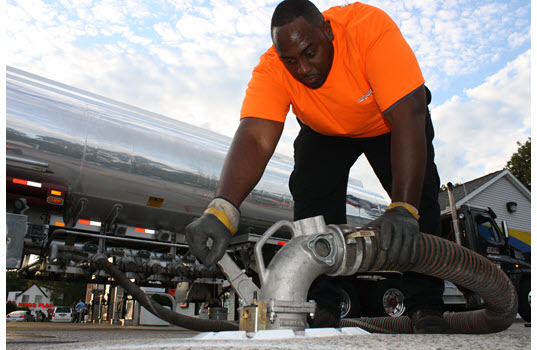By Randy Robinson, Civacon
Ensuring that the correct type and amount of fuel is delivered each and every time is the responsibility of the fuel supplier. Studies show that an incorrect octane mix will occur once out of every 14,000 gasoline deliveries. Also, one out of every 45,500 deliveries will see gasoline mistakenly dropped into a diesel UST, or vice versa.
The explanation for this is simple: tank-truck drivers are human, and humans can fall prey to making mistakes. In fact, that’s the No. 1 reason for an incorrect fuel drop: a distracted driver connects the delivery hose to the wrong underground storage tank. Another cause is improper or unclear fuel-identification markings of the USTs at the delivery site.
The effects of an incorrect fuel drop can be far-reaching. The most obvious is that the station may need to be shut down for several hours as the tanks are emptied of the contaminated fuel and cleaned, all before a batch of new fuel must be trucked in and unloaded. Secondly, any vehicles that are filled with either improper or contaminated fuel can become damaged, and the driver could come back to the retailer for reparations, or at the very least, choose to do business elsewhere. Finally, any cleanup operation or vehicle damage can generate bad press that can scar the retailer’s reputation and result in lost customers and business.
To avoid fuel mis-drops, many delivery fleets have instituted a diesel-first policy for their drivers, meaning that the driver will always unload diesel first in the hopes that many mistakes can be avoided.
Beyond mis-drops, a second major concern is a disputed delivery amount. This occurrence is around three times more likely to happen than an octane mixup, with one in every 4,000 deliveries questioned. With the average trailer making 3,650 deliveries a year, this is just slightly less than one disputed delivery per year per trailer.
There are four main causes of a disputed delivery amount:
- The trailer may have lost air pressure as it was being unloaded, which causes a valve to close before the fuel compartment is completely empty
- The driver forgets to unload a compartment, or never opens it
- The trailer is parked on an unlevel surface while being unloaded, which can prevent the full product load from completely draining into the UST
- The driver closes the fuel compartment too early
To help indicate whether the fuel compartment has drained completely, drivers will perform a bucket test after offloading. In this exercise, a bucket is placed under the trailer’s piping outlet while the compartment is opened to see if any residual fuel drains out. However, this is not a reliable check for an empty compartment because empty piping does not necessarily mean an entirely empty fuel compartment.
The most detrimental outcome of a disputed fuel delivery is the damage that can be caused to the relationship between the fuel-delivery company and the retailer. If this error occurs too often, it can lead to relationship-related damage that is not easily undone and can ultimately result in the fuel retailer looking for a new fuel supplier.
Make No Mistake
Thankfully, incidents of fuel mis-drops or incorrect delivery amounts may soon be a thing of the past. This is thanks to new, highly engineered – but easy-to-use – tank-monitoring technology that uses an easy-to-read graphic touchscreen display that communicates wirelessly with the trailer’s fuel-delivery and operation-monitoring components. Through the touchscreen display, the system consolidates the driver’s access to the many different control systems on a fuel trailer – including overfill detection, pneumatic (air pressure) control, product-crossover prevention, electronic product grade indicators (PGIs), system troubleshooting and usage history.
If an incorrect truck-to-UST connection is attempted, the trailer’s valves will not open and the delivery will be unable to commence. At the conclusion of the delivery process, which only ceases when the compartment is empty, the touchscreen notifies the driver that the compartment is empty and that all hoses, elbows and adaptors can be safely disconnected.
Conclusion
Tank-truck drivers are the undisputed lifeblood of the fuel-delivery industry, combining to perform millions of fuel drops in any given year. The vast majority of the drivers are fully committed to performing their job without fail, but even the best, most conscientious of them can fall victim to a delivery mistake such as unloading the wrong fuel into the wrong UST, or dropping an incorrect amount of fuel. When incidents like these occur – rare though they may be – there can be far-reaching negative effects for both the fuel supplier and the fuel retailer. Help has arrived, though, in the creation of a new fuel-delivery monitoring system that virtually ensures all types of fuel mis-drop incidents will be relegated to the dustbin of history.
 Randy Robinson is Engineering Manager for Civacon, Hamilton, OH. He can be reached at (800) 560-6601, or [email protected]. Civacon is delivering what’s next through innovations designed to enhance safety, reliability, efficiency and business performance for the cargo tank industry. Civacon manufactures products and systems to safely load and unload petroleum, dry bulk and petrochemical cargo tanks. Civacon is part of OPW, a leading equipment manufacturer in the retail fueling, fluid-handling and car-wash industries. OPW has manufacturing operations in North America, Europe, Latin America and Asia Pacific, with sales offices around the world. OPW is part of Dover Corporation. To learn more about how Civacon is delivering what’s next in the cargo tank industry, visit civacon.com.
Randy Robinson is Engineering Manager for Civacon, Hamilton, OH. He can be reached at (800) 560-6601, or [email protected]. Civacon is delivering what’s next through innovations designed to enhance safety, reliability, efficiency and business performance for the cargo tank industry. Civacon manufactures products and systems to safely load and unload petroleum, dry bulk and petrochemical cargo tanks. Civacon is part of OPW, a leading equipment manufacturer in the retail fueling, fluid-handling and car-wash industries. OPW has manufacturing operations in North America, Europe, Latin America and Asia Pacific, with sales offices around the world. OPW is part of Dover Corporation. To learn more about how Civacon is delivering what’s next in the cargo tank industry, visit civacon.com.









